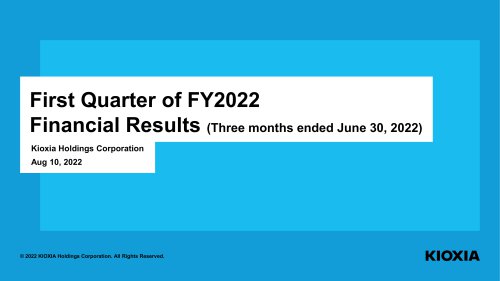
Catalog excerpts

WHITE PAPER Introducing the EDSFF E3 Family of Form Factors Bill Lynn, Dell® Paul Kaler, HPE® John Geldman, KIOXIA
Open the catalog to page 1
WHITE PAPER Introducing the EDSFF E3 Family of Form Factors Industry Landscape In today’s world, server designers are faced with a myriad of new requirements poised by an ever-changing set of use cases. Driven by new technologies, classical servers are finding their way into a broad spectrum of environments. These servers can be located anywhere from high density data centers to smaller distributed edge deployments. Advancements in CPU, memory, accelerator and networking technologies are pushing the limits of the server storage architecture. Several years ago, the industry realized that the...
Open the catalog to page 2
WHITE PAPER Introducing the EDSFF E3 Family of Form Factors The E3 Family The E3 family of devices currently consists of four different form factors that are defined by a group of SNIA SFF specifications. The SNIA SFF specifications that define the E3 family include: Specification Enterprise and Datacenter Device Form Factor Protocol Agnostic Multi-Lane High Speed Connector Enterprise and Datacenter Standard Pin and Signal Specification (EDSFF) Thermal Characterization Specification for EDSFF Devices SNIA SFF specifications are available to the public at:...
Open the catalog to page 3
WHITE PAPER Introducing the EDSFF E3 Family of Form Factors E3 devices also support two LED locations on its front face that have the following functions4: Status LED: The Status LED is green or green/white bi-color and indicates the overall status of the device. The green element is mandatory for all device variations and is controlled by the device firmware. The white element is optional and may be implemented by devices that require indication when it is safe to remove the device from the host. If implemented, the white element is controlled by the device firmware. The white element...
Open the catalog to page 4
WHITE PAPER Introducing the EDSFF E3 Family of Form Factors By using the E3 form factor platform, designers can significantly increase overall system airflow while maintaining a relatively large number of devices (in this case 15) to increase storage subsystem performance. The figure below shows a similar approach with a 2U chassis. In the example above, the system supports forty (40) E3 devices. Another challenge facing platform architects is the changing role of the server storage subsystem. Historically, the front of a server has been dedicated to traditional storage devices, but with...
Open the catalog to page 5
WHITE PAPER Introducing the EDSFF E3 Family of Form Factors Key Benefits The new E3 Family provides a number of key benefits to both system architects/designers and end-users alike, and fall into six categories as follows: Flash-optimized Form Factors Maximize Density and Performance Designed specifically to enable flash memory capacity to maximize SSD density Scalable Connector Design, Multiple Link Widths and Future Support for PCIe Supports device link options (up to x16) within the same chassis, accommodates multiple devices and power profiles from 25W to 70W, and is ready for future...
Open the catalog to page 6
WHITE PAPER Introducing the EDSFF E3 Family of Form Factors When will E3-enabled Products be Market-available? E3-enabled products are in development and will be subjected to extensive validation and interoperability testing before market availability. Stay tuned for new products that have successfully passed these testing programs. Early E3-enabled system-level solutions may sample in late 2021, with ramp up in 2022. Summary The EDSFF E3 Family of form factors delivers on the promise of evolving SSDs to address future enterprise infrastructure requirements while supporting a variety of new...
Open the catalog to page 7All KIOXIA catalogs and technical brochures
-
EXCERIA PLUS Portable SSD
3 Pages
-
EXCERIA SATA SSD
3 Pages
-
EXCERIA NVMe ™ SSD
3 Pages
-
EXCERIA G2 NVMe™ SSD
3 Pages
-
EXCERIA PLUS G2 NVMe ™ SSD
3 Pages
-
EXCERIA PRO NVMe™ SSD
3 Pages
-
Enterprise SSDs
2 Pages











